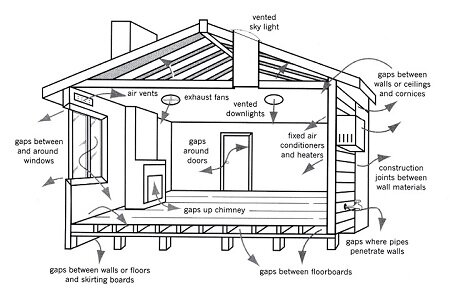10 key principles for a Solar (Light) House in the Canberra climate
1. Orientation
In Australia, the sun tracks lower in the northern sky during winter, and higher in the sky during summer. In Canberra, the lowest midday angle in winter is 31 degrees and the highest midday angle in summer is 78 degrees. The sunrise and sunset positions also vary from 30 degrees north of east and east in winter, to 30 degrees south of east and west in summer (so very early and very late summer sun can actually get you from the south!). We can take advantage of these different angles to passively heat and cool our homes. Most of your window area should face north, with appropriately sized and positioned horizontal shading above, such as an eave. This means that in summer it will be completely shaded, but in winter the low angle sun will flood several metres into the room.
East and west windows will always be hit by lower angle morning or afternoon sun, particularly in summer, and be in shadow for the other half of the day, so they should be avoided or minimised. In summer, you should shade them with retractable or removable vertical shading (or deciduous planting), and in winter you should leave them unshaded. Southern windows will almost never be in sunlight (except at the height of summer), so they too should be minimised and used sparingly just for natural light or cross ventilation.
Choosing a block with a long axis facing north is the easiest to design for, with north to the back coming second, and north to street being the hardest due to garage or carports taking prime position. However, we don’t dismiss any block and find that great results can be achieved on all of them. The house above on the right is the trickiest orientation, but we still achieved 7.5 stars and sunlight penetrating the dining, study room, and master bedroom. Jenny's house, built on a long skinny north to the street block achieves a rating of 8.2 stars!
2. Insulation
We all know how insulation works, but what should you prioritize? First should be ceiling insulation, then wall, and then underfloor. For a new build it’s very cost effective to install R5 to the ceiling, R2.5 to the walls, and R1 underfoot. It’s critical to ensure insulation is thoroughly installed with NO GAPS. Just 5% gaps in R5 ceiling insulation halves the effective R value (ie. heat is transferred twice as fast). A thermal camera can be used to check installation. At Light House we also insulate internal walls with R1.5 to assist thermal zoning and sound dampening of the home.
3. Windows
Windows are effectively big holes in your nicely insulated wall. Too many windows will negate all the effort you’ve put in to insulating your walls. Installing anything less than double glazing in Canberra’s climate is pretty silly, and not cost effective. But also think about the window frames; aluminium frames are hugely conductive and will transfer the hot or cold, in or out.
Better options are timber frames, composite frames that have aluminium externally and PVCor timber internally, full PVC (tilt&turn) windows, or thermally broken windows. High transmission low-e coatings on glass are a great option in Canberra because they have very little impact on the direct radiant heat gain from sun shining through, but still have reduced conductivity so they have greater capacity to keep the warm in, and the cool out, or vise-versa. Good curtains or blinds, and pelmets are also encouraged and improve the thermal properties of the house significantly.
4. Thermal Mass
Once you’ve got orientation right you can use thermal mass to increase passive heating and cooling. Thermal mass refers to a material with a high capacity to store and radiate heat such as concrete. In winter, the sun floods in and hits the slab warming it during the day, and during the evening it re-radiates this heat through the house. In summer, we shade adequately so no sun hits the slab. At night we open all the windows, cool the slab down, and then during the following day the slab can absorb some of the heat from the air in the house and essentially help reduce this inside temperature.
5. Thermal Breaking
Any conductive elements that connect from inside to outside should be thermally broken so they don’t create what we call a ‘thermal bridge’. A big culprit is the concrete slab. There should be a thermal break between any outdoor slabs (garages, carports, patios).
If we were in Sydney, we would want to encourage the thermal bridging or coupling between the house and the ground so that in hot weather the slab could release heat to the cool ground. But we are in quite a different climate in Canberra, and we have a far bigger heating load during the cooler months, so we want to insulate between the slab and the ground, as well as the edge of the slab, to make the heating potential the priority for our big source of thermal mass. NB. this approach assumes good solar passive design that makes the most of the orientation, eaves and external shading to ensure that the summer sun does not strike the slab.
6. Air Leakage
In parts of North America and Europe there are legislated standards for air leakage, but it’s a relatively new concept in Australia. The average Canberra home replaces its entire volume of air every hour – but it doesn’t take much to reduce this significantly. Ducted heating systems and the craze for hundreds of downlights are a current trend to be avoided. Limit every hole in your beautifully construct home. Use pendant lights, wall lights, pelmet lights. Use radiant heat systems instead of ducted. Seal around every window and door and electrical or plumbing penetration. We also do square set cornices to limit air leakage.
At Light House, we use a blower door to test the air leakage on every house we complete. Most Canberra homes rate at about 15-30 air changes per hour at @50 pascal testing conditions. We aim for a rating of 5-8. Below 3 ACH @ 50Pa you need to install mechanical ventilation systems to ensure indoor air quality. The German Passivhaus standard is 0.6ACH or less! Our opinion is that great results can be achieved without going to this extreme level of airtightness, and save on the additional of a mechanical ventilation system.
7. Resources
We encourage people to go all electric. You will save by not paying for a gas connection and you have the ability to offset your energy usage by generating your own photovoltaic power. One of our former family-of-four clients uses only 16% of the electricity expected for four person households in their area and they generate nearly four times as much energy as they use! Solar hot water is by far the single most efficient green system you can install in your home. We recommend evacuated tube systems oriented north and pitched at an angle of around 55 degrees for the Canberra climate.
Are you capturing as much water as you can to be used in your toilet, washing machine, and garden? Are the materials use in the building sourced ethically? How far have they travelled? How long will they last? Are they easily deconstructed and recycled? Most of all, investing in a well designed home will ensure it’s longevity, which is arguably the most successful move of all.
8. Location and Lifestyle
Where we choose also affects how sustainable our lifestyle is. If you can’t afford to live close to work or services, can you live near community node or public transport line. Does your home facilitate any sustainable hobbies you have such as cycling, chickens, composting or veggie gardens.
9. Heating and Cooling
An 8 star home does not need air conditioning for cooling. Ceiling fans and cross ventilation should provide sufficient cooling. Windows should be placed to encourage natural ventilation. We also install higher than standard doors for a sense of spaciousness but also increased air flow. If you have to have an air conditioner, aim to power it with solar power.
For heating we would recommend radiant heat systems such as far-infrared panels on the ceiling or wall, electrical wall panel heaters, portable heaters, and under tile heating in bathrooms. Radiant heat is also more pleasant than fan heat, and limits those holes in your home’s precious building envelope. We tend to discourage in slab hydronic heating as it is expensive to install and unnecessary if you have used the solar passive design principles… on a beautiful sunny day in winter our homes can actually get too warm very quickly, without the ability to instantly switch off supplementary heating.
10. Operation
No matter the house you live in, you need to remember that houses need to be run or managed correctly, like a machine. In summer, open it up over night to cool it down, and close it up in the morning to keep the heat out. In winter, open the blinds when the sun streams in, close them when it goes down. Take your fly screens off northern windows in winter – you’d be surprised how much they reduce the radiant heat gain!
At Light House we believe that traditional construction methods are the still the most cost effective in Canberra and that by using the 10 principles discussed we find it relatively easy to achieve 8 star homes in the Canberra climate for reasonable costs.
What kind of difference do these 10 techniques make to a home?
We’ve completed some test modelling and found that just by having a well oriented cleverly designed floor plan, we could achieve the 6 star minimum without any materials or extras above bulk standard building practice.
*The next step was insulating underneath and the side of the slab, which made huge improvement to 7 stars.
*Step three was to increase wall and ceiling insulation to get to 7.5 stars.
*Step four was to double glaze the living area windows, pushing us to 8 stars.
*Step five was double glazing and changing to thermally broken windows.
*Step six was applying a low-e coating to all windows.
*Step seven was applying appropriate shading to east and west windows.
*Step eight was installing drapes and pelmets, which aren’t technically modelled in EER software, but effectively assisted in achieving a solid 8.5 star rating.
Remember, an 8.5 star home uses 66% less energy than a 6 star home – it’s not a linear scale.





